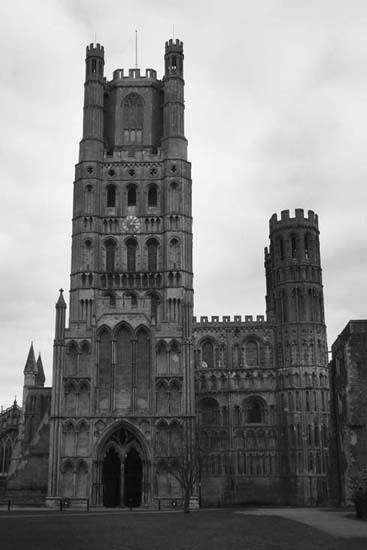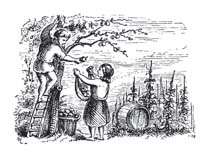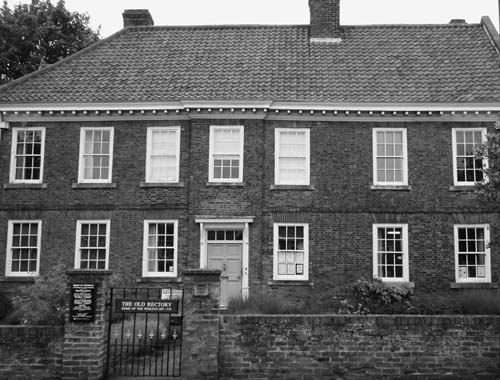Folklore of Lincolnshire (16 page)
Read Folklore of Lincolnshire Online
Authors: Susanna O'Neill

The siege is said to have lasted six years, with King William trying different tactics to overthrow Ely. First, after creating a blockade around the Isle guarding all known exits, he decided to create a causeway of masses of alder branches overlaying the reeds, with stones, sticks and huge timbers lashed together. However, Hereward and his men were lying in wait and ambushed William’s attempts, destroying the causeway and killing hundreds of his men, many others being sucked down into
the marshes in their heavy armour and drowning. It is said that many years passed before the Fen-men ceased dragging up bodies of those Normans who had sunk into the depths that day.
While William was regrouping, legend states that Hereward ventured out, getting past the enemy defences and disguised himself as a potter, in order to glean the plans of the Normans. He penetrated the enemy camp and discovered they were planning to use a witch against him but later he was recognised and had to fight his way out, relying on his trusty stead, Swallow, to get him away from trouble. He managed to get back to Ely with important information about the new attack and began to put a plan together to foil it.
The King employed a series of boats in his next attack and also built up mounds for soldiers to fight upon and towers from which he could deploy catapults and other weapons. It was upon one of these towers that the witch was mounted and began to utter her spells and incantations, to provoke and scare the rebels.

Ely Cathedral Abbey.
Hereward and his men had, however, been infiltrating the enemy lines, disguised as fishermen, and it was now that they threw off their disguises and set fire to all the platforms, mounds and towers. The Normans who survived the flames are said to have fled in terror and the witch fell from her collapsing, fiery tower and broke her neck. Hereward and his men picked off any remaining survivors and thus triumphed over the Normans yet again.
It would seem that the siege could have lasted a good many more years, with who knows what outcome, if Hereward had not been betrayed. The monks of Ely were growing tired of the siege and wished to win the King’s favour. Abbot Thurstan made a pact with the King and showed his army a secret way across the Fens. Hereward and his men were surprised by this attack and thousands were killed or captured but the story goes that Hereward himself managed to escape, guided through the marshes by a mysterious white wolf.
The facts become even more clouded from here. Hereward seems to have continued his rebellion, attacking the Normans whenever he could, sacking Peterborough and Stamford and eventually being caught and imprisoned. Another story tells that he made his peace with the King and lived side by side with him ever after, with his new wife, Alftrude. Yet another states that he met his end when he was set upon one night by a band of Normans. He apparently managed to slay fifteen or sixteen of them single-handedly, but then was stabbed in the back by another four who came in from behind.
Rex believes that each of the differing medieval stories stemming from the Fenland monasteries had a different perspective to show, with varying priorities about how Hereward should be viewed, and so this is one reason why the facts of what happened to him are so unclear.
No one really knows the ultimate fate of this heroic Englishman and thus he melds into the realm of legend, but is forever remembered as a champion of English liberty!
T
HINGS THAT GO
B
UMP IN
THE
L
INCOLNSHIRE
N
IGHT

I include a chapter on ghosts and hauntings because throughout the centuries they have always held a certain amount of fascination for people from all walks of life. Indeed today, producers now use ghost-hunting programmes as a form of ‘reality television’, but the majority of ghost stories originate from the past and many are closely linked with folk history. As the second largest county in England, covering nearly 6,000 square kilometres, Lincolnshire is destined to be inundated with legends of ghosts, phantoms and unexplained occurrences. Like all the counties on this historical island, Lincolnshire has its fair share of castles, churches, cathedrals, stately homes, abbeys and historical sites, many of which claim their own particular brand of haunting.
Not only one of the most famous hauntings of Lincolnshire but also one of the most famous cases of suspected poltergeist activity in Britain occurred in 1716 and 1717 at Epworth Rectory, situated in the Isle of Axholme. The Reverend Samuel Wesley and his family, including John and Charles Wesley, the founders of Methodism, owned the house at the time.
It was the children and servants who first began to complain of hearing knocking sounds in the house, accompanied by peculiar groans and mysterious footsteps at all hours of the night. One of the children identified one sound as the tread of a man’s heavy leather boots. The reverend, however, heard no such noises and reprimanded the children for such fabrications, until a few nights later he finally heard loud thuddings against his own bedchamber wall. At first he believed that someone had entered the house and was causing trouble. This would not have been so far-fetched as, back in 1709, disgruntled villagers who did not agree with his stern principles had set his house on fire. Some livestock had been injured and the rectory had to undergo some building work to repair it, but no one was hurt.
However, it transpired that no one was anywhere near the rectory on this particular night.
The following is an extract taken from a letter Mrs Wesley wrote to her absent son, Samuel, to inform him of the strange goings on:
On the first of December our maid heard, at the door of the dining-room, several dismal groans, like a person in extremes, at the point of death. We gave little heed to her relation, and endeavoured to laugh her out of her fears. Some nights (two or three) after, several of the family heard a strange knocking in divers places, usually three or four knocks at a time, and then stayed a little. This continued every night for a fortnight; sometimes it was in the garret, but most commonly in the nursery, or green chamber. We all heard it but your father, and I was not willing he should be informed of it, lest he should fancy it was against his own death, which, indeed, we all apprehended. But when it began to be troublesome, both day and night, that few or none of the family durst be alone, I resolved to tell him of it, being minded he should speak to it. At first he would not believe but somebody did it to alarm us; but the night after, as soon as he was in bed, it knocked loudly nine times, just by his bedside. He rose, and went to see if he could find out what it was, but could see nothing. Afterwards he heard it as the rest.
1
To counter any more untoward behaviour, the reverend bought a guard dog, but the first night the imposing beast heard the knocking he fled whimpering behind his master’s legs. Glasses were heard smashing, windows broken and Mrs Wesley even heard the sound of a bag of coins being emptied at her feet. Even though the bangs and crashes were demonstrably noisy and the family searched every room in the house, there was no-one to be found, nothing untoward to be seen.
One night, when the knockings were particularly loud on the nursery door, the reverend lost his temper and shouted at the spectre to leave the children alone and bother him instead. The spectre obliged and directly came knocking on his study door. The reverend also reported being pushed by an unseen force in his study. Even the clergyman they called in to help fled the house in fear after a rather raucous show!
Eventually the children became accustomed to the presence and nicknamed him ‘Old Jeffery’. One of the daughters claimed to have actually seen him once – a man in a long, trailing, white robe – while others asserted they had seen some animal creature appearing as a badger, rat or even a white rabbit, scuttling under their beds. Perhaps the strangest thing about the whole incident is that it apparently stopped as abruptly as it had started, with no explanation as to who or what had been the cause. Suggestions include witchcraft, the curse of an unhappy marriage, the daughters’ development into womanhood, and Jacobite grumblings – but the reverend had his own theory. The story tells that one night at prayer, the reverend noticed his wife did not say ‘Amen’ at the end of the prayer for the King. When questioned on this matter, she said she refused on the grounds that the Prince of Orange was no
King. The reverend then vowed he would not live with her again until she retracted this and he left the house for a year. When he returned, she apparently had still not taken it back, so when the knockings and bangings began, the reverend believed it was due to him breaking his vow, which had not been forgotten by God.

The Old Rectory at Epworth, the home of John Wesley and the poltergeist Old Jeffery.
The actual term ‘poltergeist’ originates from the German
poltern
, which means to knock or break, and
geist
which translates as spirit, or ghost. Generally poltergeist activity starts and stops very abruptly, which is one of the reasons it was believed Epworth Rectory had been visited by one, rather than a demon or any other type of ghost. The Old Rectory is now open to the public as a museum to the life and works of the Wesley brothers, so you can visit yourself and walk in the footsteps of Old Jeffery.
Folklorist Ethel Rudkin mentions more Lincolnshire poltergeist activity happening at Owmby Abbey, near Caistor (now replaced by cottages). She relates the tale of a man who was passing by when he saw a woman who had fainted. She was:
…laid in’ the causey, an’ she’d fainted wi’ fright, on account of ‘er ‘avin’ been sittin’ in the room with one o’ the childer when there started such a din! In the corner cupboard the teaspoons was all put away in the milk-jug – well – they all started tittuppin’ – then, woosh! Down when the blind, an’ she screamed an’ ‘id ‘er face. When she looked up, blind wasn’t down at all, it was up!
2
Another episode tells of the kitchen fire lighting itself and people hearing it crackling, but when they looked again there was no fire lit.
Local researcher Daniel Codd recounts a poltergeist haunting a house in Leasingham, near Sleaford, in 1679.
3
Occurrences included the latch on the door jiggling of its own accord, doors slamming, phantom footsteps and knockings and chairs gathering by themselves and then returning to their proper places in the house. Codd adds that this particular poltergeist had the strange habit of copying sounds it heard around the house, such as workmen banging, or servants breaking coals, but would repeat them during the evening, when the workmen had gone home.
Codd also tells of a poltergeist-like haunting at the Old Rectory at Fulletby, near Horncastle. He explains that during the 1800s some renovations were being made to the building, during which time an old skull was found. It was buried in the churchyard but the following morning it was discovered amongst the builders’ rubble. It was again buried in the churchyard but the unexplained excavation was repeated the following morning. In the end the superstitious builders walled the skull up in the chimney place of the new building. The poltergeist activity started following these events. Loud banging and smashing sounds were heard. Servants reported waking in the middle of the night to find their bed sheets had been stripped and thrown across the room. In 1840 the house had more renovations and the chimney was demolished. This brought an end to the poltergeist haunting.
